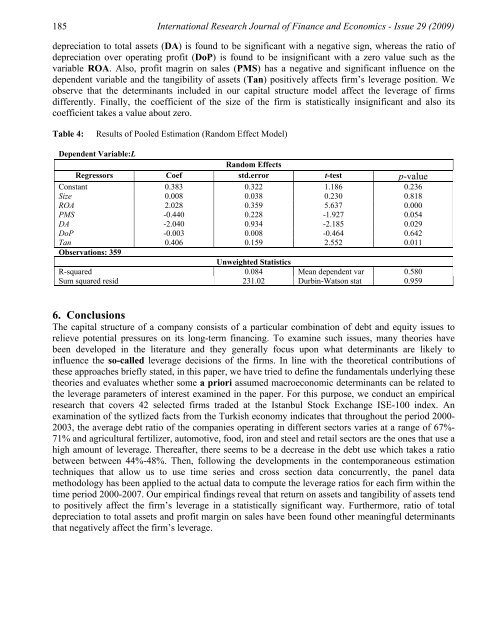Determinants of Capital Structure for Turkish Firms: A Panel Data ...
Determinants of Capital Structure for Turkish Firms: A Panel Data ...
Determinants of Capital Structure for Turkish Firms: A Panel Data ...
Create successful ePaper yourself
Turn your PDF publications into a flip-book with our unique Google optimized e-Paper software.
185 International Research Journal <strong>of</strong> Finance and Economics - Issue 29 (2009)<br />
depreciation to total assets (DA) is found to be significant with a negative sign, whereas the ratio <strong>of</strong><br />
depreciation over operating pr<strong>of</strong>it (DoP) is found to be insignificant with a zero value such as the<br />
variable ROA. Also, pr<strong>of</strong>it magrin on sales (PMS) has a negative and significant influence on the<br />
dependent variable and the tangibility <strong>of</strong> assets (Tan) positively affects firm’s leverage position. We<br />
observe that the determinants included in our capital structure model affect the leverage <strong>of</strong> firms<br />
differently. Finally, the coefficient <strong>of</strong> the size <strong>of</strong> the firm is statistically insignificant and also its<br />
coefficient takes a value about zero.<br />
Table 4: Results <strong>of</strong> Pooled Estimation (Random Effect Model)<br />
Dependent Variable:L<br />
Regressors Coef<br />
Random Effects<br />
std.error t-test p-value<br />
Constant 0.383 0.322 1.186 0.236<br />
Size 0.008 0.038 0.230 0.818<br />
ROA 2.028 0.359 5.637 0.000<br />
PMS -0.440 0.228 -1.927 0.054<br />
DA -2.040 0.934 -2.185 0.029<br />
DoP -0.003 0.008 -0.464 0.642<br />
Tan<br />
Observations: 359<br />
0.406 0.159<br />
Unweighted Statistics<br />
2.552 0.011<br />
R-squared 0.084 Mean dependent var 0.580<br />
Sum squared resid 231.02 Durbin-Watson stat 0.959<br />
6. Conclusions<br />
The capital structure <strong>of</strong> a company consists <strong>of</strong> a particular combination <strong>of</strong> debt and equity issues to<br />
relieve potential pressures on its long-term financing. To examine such issues, many theories have<br />
been developed in the literature and they generally focus upon what determinants are likely to<br />
influence the so-called leverage decisions <strong>of</strong> the firms. In line with the theoretical contributions <strong>of</strong><br />
these approaches briefly stated, in this paper, we have tried to define the fundamentals underlying these<br />
theories and evaluates whether some a priori assumed macroeconomic determinants can be related to<br />
the leverage parameters <strong>of</strong> interest examined in the paper. For this purpose, we conduct an empirical<br />
research that covers 42 selected firms traded at the Istanbul Stock Exchange ISE-100 index. An<br />
examination <strong>of</strong> the sytlized facts from the <strong>Turkish</strong> economy indicates that throughout the period 2000-<br />
2003, the average debt ratio <strong>of</strong> the companies operating in different sectors varies at a range <strong>of</strong> 67%-<br />
71% and agricultural fertilizer, automotive, food, iron and steel and retail sectors are the ones that use a<br />
high amount <strong>of</strong> leverage. Thereafter, there seems to be a decrease in the debt use which takes a ratio<br />
between between 44%-48%. Then, following the developments in the contemporaneous estimation<br />
techniques that allow us to use time series and cross section data concurrently, the panel data<br />
methodology has been applied to the actual data to compute the leverage ratios <strong>for</strong> each firm within the<br />
time period 2000-2007. Our empirical findings reveal that return on assets and tangibility <strong>of</strong> assets tend<br />
to positively affect the firm’s leverage in a statistically significant way. Furthermore, ratio <strong>of</strong> total<br />
depreciation to total assets and pr<strong>of</strong>it margin on sales have been found other meaningful determinants<br />
that negatively affect the firm’s leverage.

















